Stereophile
Direct Acoustics Silent Speaker II
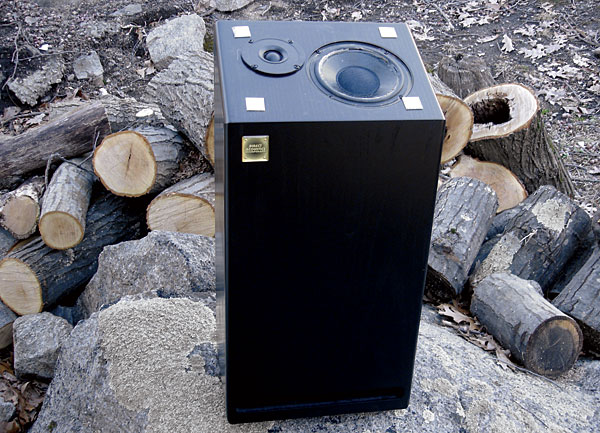
Direct Acoustics is a loudspeaker company in Weston, Massachusetts, that sells, by mail-order only, just one product: the two-way, floorstanding Silent Speaker II ($748/pair).Its seemingly paradoxical name refers not to any inability of the Silent to create sound, but rather is intended by its maker to indicate two aspects of its performance. First is the ability of the loudspeaker boxes to “disappear” in the sense of not being readily apparent as sound sources. Well, okay, everyone wants that. The other intended sense of Silent is that the woofer and its loading arrangement were designed to minimize stray noises created by the woofer’s excursion, or by the movements of air within, or in and out of, its vent or port.
Direct Acoustics, founded in 1995, is the brainchild of Winslow Burhoe, an important figure in the history of modern loudspeaker design. In 1960, Burhoe had been studying pipe organ at the New England Conservatory when he was chosen for an internship at Acoustic Research, and the direction of his life was set. He assisted Edgar Villchur on the design of the AR4. He went on to found EPI/Epicure loudspeakers (later acquired by Harman International), Burhoe Acoustics, and Direct Acoustics. (He influenced designs from KLH, Snell, Boston Acoustics, Audio Products International (aka API, and for whom he reworked a late prototype of the Energy 22), and others.
The Silent Speaker II is a wide, rectangular box whose top panel is raked at an angle of about 22°: the enclosure is about 22″ tall at the front, 25″ tall at the rear, 13.5″ wide, and 9″ deep. The top panel holds a 6.5″ woofer and a 1″ soft-dome tweeter. Each speaker weighs about 25 lbs. A recess in the upper part of the rear panel holds one pair of binding posts with red and black plastic hex nuts. The pairs are mirror-imaged; I positioned them with the tweeters to the inside. A port about 1″ tall runs nearly the full width of the bottom of the front panel. The speakers come with grilles of stretched black fabric that are secured to the top panel with squares of adhesive foam. The edges of the enclosure are rounded, with a round, compliant foot about 1/4″ thick at each corner.
The Silent Speaker II is available in one finish: black ash veneer. Its monolithic look isn’t really contemporary, but the design brief doesn’t appear to have been “Sound okay and win beauty contests.” Compared to recent offerings from any number of companies—such as PSB, whose curved enclosures are elegantly veneered and stained—the Silent looks a bit dated, even DIY. But I don’t think that that will matter to the right customers, who will ignore the styling and the somewhat handmade look of the woofer cones, and enjoy a much wider frequency extension than is offered by any other basically listenable loudspeaker at or near its price.
Direct Acoustics claims for the Silent Speaker II frequency responses of 40Hz–10kHz, ±2dB; 30Hz–17kHz, ±4dB; and 20Hz–20kHz, ±6dB (!). No sensitivity is specified. Also stated are impedances of 6 ohms average and 4 ohms minimum.
Visually and, to an extent, through its acoustical approach, the Silent Speaker II calls to mind three venerable speakers from what I term a Golden Age of Audio (1970s–1980s): Stig Carlsson’s Sonab omnidirectional, Shahinian Acoustics’ Arc polyradial, and the Epicure Model 20. All are rather squat floorstanders that fire as much toward the ceiling as toward the front, but after that the similarities taper off.
The Sonab had four leaf tweeters arranged in a square pointing up at about 45° from the top of a rectangular woofer enclosure. I heard a pair ca 1976 and was thoroughly gobsmacked—their sound was so much more dimensional, vivid, and tactile than from the Klipschorns the dealer had in the same room. (Of course, it’s possible that the dealer had intentionally set up the K-horns poorly.)
Shahinian’s Arc, still in production at $5500/pair, looks quite similar to the Silent Speaker II, except that it’s much more complicated. The Arc is a three-way design with the woofer, midrange, and tweeter all on the canted top panel, and a passive bass radiator on the rear, at the end of a transmission line. I heard the Arcs more than a decade ago, when I was writing forThe Abso!ute Sound, and was very impressed by their natural timbre, superwide soundstaging, and their bass and dynamics—when driven by an amplifier with adequate current and damping factor.
Epicure’s Model 20, of course, is a direct ancestor of the Silent Speaker II, with a nearly identical cabinet shape. (If I ever heard the Model 20, I don’t recall it, but I certainly recall the post-Burhoe EPI 3.0—the first great loudspeaker I heard that was tantalizingly just beyond my financial reach.) Epicure’s “secret sauce” was to create different loudspeakers out of combinations of a basic module Burhoe designed, which consisted of one 8″ woofer and one 1″ tweeter and the necessary crossover components. The Model 20 had comprised two of these modules, and therefore was somewhat bulkier than the Silent Speaker II.
Direct Acoustics Silent Speaker II Page 2
Although I had been aware of Direct Acoustics for at least a year and probably two, had bookmarked its website, and had it in mind to eventually get in touch, what prompted me to take action was a conversation I had late last year, at Parsons Audio’s annual trade fair, with the recording engineer and musician Micha Shattner. Micha has some of the best ears I have ever seen at work, and he does not gush praise as a standard operating procedure. Indeed, he did not gush at all over the Silent Speaker II; he simply said that, at the price, there was nothing like it. He also said that, owing to the Silent’s cabinet shape and driver disposition, one could position a second pair back to back with the first pair’s left and right speakers, thus gaining a more efficient coupling to the room, and dispersion performance that would be closer to the omnidirectional ideal.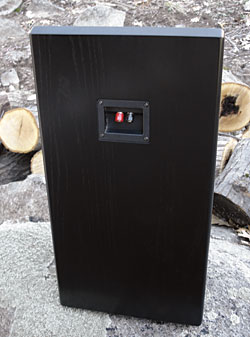 One final point before I get to my listening impressions: On Direct Acoustics’ website, Burhoe claims that stereo imaging is often pursued at the expense of timbral accuracy, and that he is more concerned with accurate reproduction of sound than of stereo imaging. I don’t have a problem with this because, at the end of the day, my evaluation of a component comes down to two metrics: does the component allow or cause me to have an emotional response to the music? and how am I going to feel when I pack these things up and ship them back?
One final point before I get to my listening impressions: On Direct Acoustics’ website, Burhoe claims that stereo imaging is often pursued at the expense of timbral accuracy, and that he is more concerned with accurate reproduction of sound than of stereo imaging. I don’t have a problem with this because, at the end of the day, my evaluation of a component comes down to two metrics: does the component allow or cause me to have an emotional response to the music? and how am I going to feel when I pack these things up and ship them back?
Listening
The Silent Speaker II is not a loudspeaker you can connect anything to and get great sound—it took me a while to get out of them a sound I really liked. In fact, when I hooked them up to Luxman’s excellent D-05 SACD/CD player ($5000), CL-88 tube preamp ($6000), and MQ-88 tube power amp ($8000), wired with about $10,000 worth of Cardas Clear cables, the Direct Acoustics didn’t sound great at all. I think there was too much top end going in through the Cardas Clears, and the tube amp didn’t do an adequate job of controlling the bottom end. Switching over to “>Ayre Acoustics’ AX-7e integrated amplifier and “>CX-7e CD player ($3500 each), using Ayre’s own balanced interconnect cables but Nordost’s new Flat 2 speaker cables ($152.49/2.5m pair with banana terminations?), gave me the best sound I was able to get. More to the point, that sound was beyond respectable—it was exciting, and it elicited from me real emotional responses.
The only fly in the ointment was that this great, eminently listenable, can’t-complain-about-anything-without-sounding-like-an-ungrateful-jerk sound was the product of electronics that cost more than 10 times the speakers’ price. The Silent Speaker IIs’ performance with the more class-appropriate TEAC and Marantz CD receivers (full coverage in a future issue), although fine, was just not as textured or engaging or blemish-free, the biggest blemish being that the budget CD receivers’ amplifier sections simply could not exercise the control over the Silents’ apparently complex bass loading that the much more expensive Ayre integrated did. So most of my comments are directed toward the best-case scenario (for the speakers) of using $7000 worth of Ayre electronics with a $748 pair of speakers. After experimentation, I set up the Silent Speaker II 3′ from the sidewalls, 4′ from the front wall, 5′ apart, and toed in directly to face the listening chair. My intention in setup was to minimize bass reinforcement from room boundaries.
The Silent Speaker II had a “traditional New England” warm tonal balance. I think that says an awful lot of everything that can be said, right there. For the most part, its errors are of omission rather than commission. Properly set up with synergistic equipment, the SSII was as listenable as all get-out. I think that two important factors were my use of Nordost’s affordable copper speaker cable, and the simple expedient of following the designer’s wishes and using the speakers with their grilles in place. I have never heard a loudspeaker before where the grilles made such a positive difference, or where their absence made the loudspeaker appreciably less listenable.
For the money, this speaker went crazy deep. For John Atkinson, I played through the Vivid B-1s a brief level-setting sound check for a pipe-organ recording session. The Silent Speaker IIs went at least as low as the Vivids, and were even a touch louder in the bass (which may be attributable to “port bass” or room reinforcement), but were nowhere near as focused. I can’t speak for Direct Acoustics’ claimed frequency responses, but I can say that, in my room, the Silents played a 32Hz low C at what sounded like full volume to me, and I’m the one who made that recording.
A relative lack of pinpoint stereo imaging is not always a bad thing. I’ve always had a problem with Bill Evans’s Village Vanguard sessions: his piano is in the right channel, and the bass and drums are in the left channel. It’s really a dual-mono recording with nothing going on in the middle. Through the Silent Speaker IIs, those recordings sounded more as if the musicians were playing (and the drinkers tinkling their glasses) live in the room than they do through speakers that image more conventionally.
Within the ambit of its warm tonal balance, the SSII did a very good job—for its price, and given its designer’s ambition that it be full-range—of integrating the outputs of its tweeter and woofer. Richard Lehnert’s speaking voice in the “Channel Phasing” track on Test CD 2 (Stereophile STPH004-2) exhibited a touch of “cupped-hands” coloration, but that didn’t noticeably affect most music; apart from the test CD, it showed up only in Andrea Bocelli and Thomas Hampson’s performance of the duet from Bizet’s Les Pêcheurs de perles, which can sound a bit hooty through any speakers.
On at least a few occasions with the class-appropriate CD receivers, and quite a bit more reliably with the Ayre electronics, the Silent Speaker IIs became things I listened to for the pleasure of hearing music, rather than out of a sense of obligation. Standout tracks included Johnny Hartman’s album with John Coltrane, Eliahu Inbal’s Mahler Fifth on Denon, opera excerpts from tenors Brian Cheney and Ben Heppner, string quartets of Ravel and Debussy by Quartetto Nuovo, and Dagmar Pecova’s luminous recording of Wagner’s Wesendonck Liederon Supraphon. Even with the CD receivers, the sound was at least as engaging as that of any speaker I auditioned two years ago—with the proviso that some, such as “>Aerial’s 5B, bit off less and therefore could chew more thoroughly. Winslow Burhoe has obviously put his half-century of experience to good use.
Summing Up
Pros: For the price: amazing bass; reasonably coherent from deep bass to upper treble; careful attention to setup will minimize colorations.
Cons: Dated looks; utilitarian design and ordinary fit’n’finish; will probably only rarely be partnered with electronics that show how good they are.
Direct Acoustics Silent Speaker II Specifications
Sidebar 1: Specifications
Dimensions: 25″ H by 13.5″ W by 9″ D. Weight: about 25 lbs.
Serial numbers of review samples: None visible.
Price: $748/pair. Approximate number of retailers: sold direct only.
Manufacturer: Direct Acoustics, 19 Lexington St., Weston, MA 02493. Tel: (617) 538-2015. Web: www.directacoustics.com.
Direct Acoustics Silent Speaker II Measurements
Sidebar 2: MeasurementsThe Silent Speaker’s electrical impedance and phase are shown in fig.1. The impedance magnitude drops below 6 ohms only between 100 and 200Hz and in the low treble, with a minimum value of 5 ohms between 120 and 160Hz. This will be an easy speaker for the partnering amplifier to drive. The twin impedance peaks in the bass in fig.1 indicate that the Silent Speaker II is a reflex design, with the large rectangular port at the base of the front panel tuned to 42Hz. There are several wrinkles between 200 and 300Hz in the impedance traces, suggesting the presence of cabinet resonances of some kind. I investigated the enclosure panels’ vibrational behavior with a simple plastic-tape accelerometer, which indeed detected very strong resonances at 211 and 277Hz (fig.2).
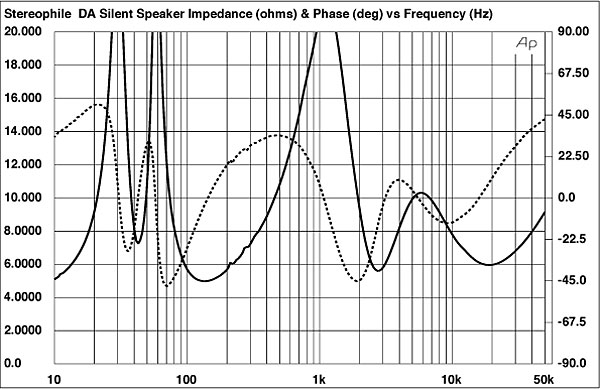
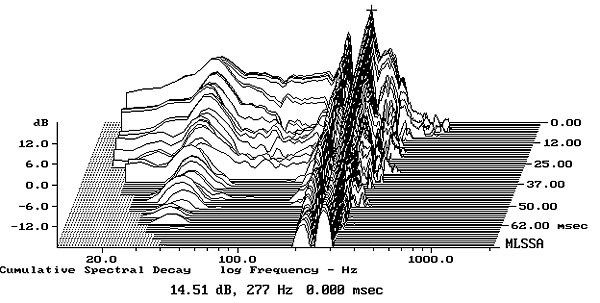
Turning to the acoustic measurements, I measured the Silent Speaker II’s frequency response in the farfield with DRA Labs’ MLSSA system and a calibrated DPA 4006 microphone. For the nearfield and room responses I used an Earthworks QTC-40. The first problem was choosing the axis on which to measure the response. With the Silent’s unusual drive-unit array—a 1″ soft-dome tweeter and a 6.5″ cone woofer side by side on the speaker’s angled top panel—choosing a point in space at which to position the measuring microphone was somewhat arbitrary. Although the tweeter is just 25″ from the floor and thus will be below the ears of a typical seated listener, measuring on an axis level with the tweeter would be readily repeatable. I performed all the measurements with the grille in place, as this is how JM auditioned the speaker.
The voltage sensitivity on this axis was low, at an estimated 83dB(B)/2.83V/m. The black trace above 300Hz in fig.3 shows the farfield response averaged across a 30° horizontal window centered on an axis level with the tweeter. There is very little output above 12kHz and the octave below that frequency is shelved down, correlating with JM’s finding the speaker’s balance to be on the warm side. There are some sharp suckouts between 800 and 3200Hz. I’m not sure what these are due to, but the crossover frequency is set at 1600Hz. Lower in frequency, the blue trace is of the output of the woofer, measured in the nearfield. It shows the expected minimum-motion point at 42Hz typical of a reflex design, and the port’s output (red trace) peaks in the same region.
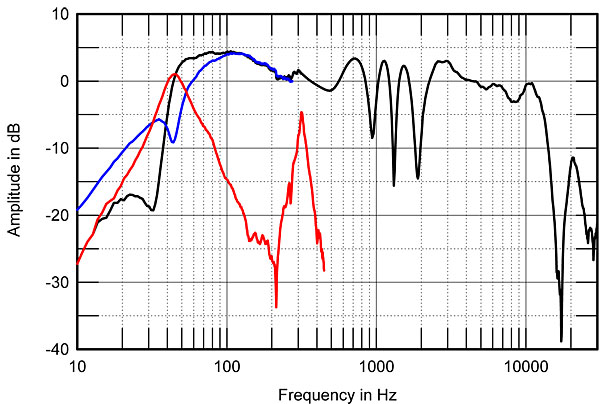
However, the summed response of the woofer and port, taking into account acoustic phase and scaling the individual outputs in the ratio of the square root of their radiating areas (shown as the black trace below 300Hz in fig.3), has a notch at 32Hz. This suggests that the port has some of the behavior of a transmission line, and that its output is not completely in opposite polarity to that of the woofer until a frequency somewhat lower than the port tuning frequency. The port has a vicious peak in its output at 312Hz, which is probably and not coincidentally the frequency of a small peak in the cabinet vibrational plot (fig.2). The rise in woofer and overall response between 50 and 200Hz in fig.3 will be due to the nearfield measurement technique; the Silent Speaker II’s low-frequency anechoic output will be flat down to below 50Hz.
The Silent Speaker II’s lateral dispersion is shown in fig.4; the suckouts in the on-axis response fill in to the speaker’s sides, more so to the front of this graph, which is on the woofer side of the baffle, which will tend to give the room’s reverberant field a more neutral character when the woofers are placed on the outside edges of the mirror-imaged pair. Overall, the horizontal radiation pattern is more even than I was expecting, considering the drive-unit layout. In the vertical plane (not shown), the suckouts tend to fill in above the horizontal axis, and the region above 10kHz rises as you get closer to the actual tweeter axis.
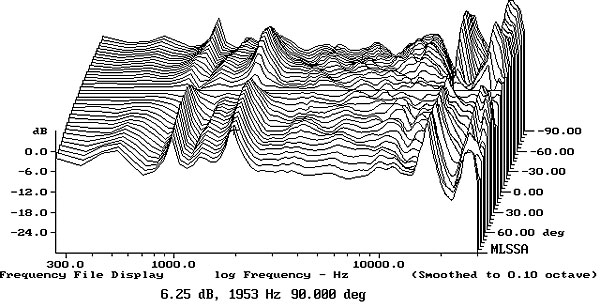
In the time domain, the Silent Speaker’s step response (fig.5) suggests that the tweeter is connected in positive polarity, the woofer in inverted polarity, though their individual steps blend smoothly. However, multiple arrivals are evident during the decay of the woofer’s step that correlate with the delayed energy evident in the waterfall plot in the region of the on-axis frequency-response suckouts (fig.6). The decay is very clean in the region covered by the tweeter, however.
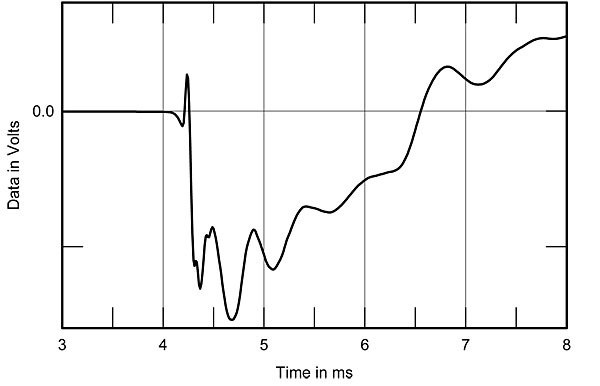
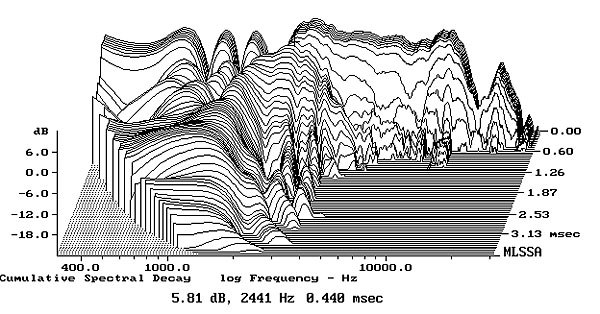
The red trace in fig.7 shows the spatially averaged response of the Silent Speaker IIs in my listening room. The speakers were about 24″ from their respective sidewalls and 72″ from the wall behind them. They were toed-in to the listening position and their tweeters were on their inside edges, which is both how JM auditioned the speakers and how the dispersion measurements suggest they should perform best. The blue trace is the spatially averaged response of my longtime reference speakers, a 1978 pair of Rogers LS3/5as. Other than an excess of energy in the mid-treble, the Silent Speaker’s in-room response between 200Hz and 2kHz is commendably even. The Direct Acoustics speaker has less energy in-room above 4kHz than the BBC minimonitor, which ties in with its warm balance. The Silent Speaker II also excites my room’s 63Hz mode far more than does the LS3/5a.
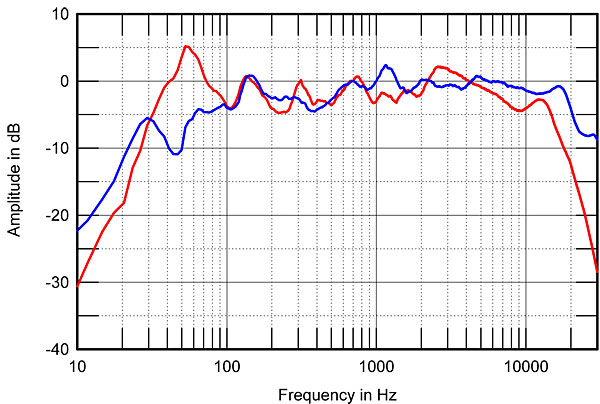
I listened to the Silent Speaker after performing and analyzing the measurements, so my expectations were not very high. However, I was pleasantly surprised when I set them up in my room and drove them with a pair of MBL 9007 monoblock amplifiers and my Mac mini feeding adCS Debussy DAC via asynchronous USB. Other than the mellow highs, the balance was considerably more neutral and uncolored than I’d expected.
Eric Whitacre’s Lux Aurumque, from the Dale Warland Singers disc of that title (CD, Gothic 49252), was reproduced with a warm, rich acoustic, the images of the singers floating above the plane of the speakers and the tonal balanced relatively uncolored. In Beethoven’s complete cello sonatas, as performed by cellist Miklós Perényi and pianist András Schiff, our “Recording of the Month” for January 2005 (CD, ECM New Series 1819/20), the sound of both instruments was rich, appealing, and uncolored. Even though I knew there were high-level cabinet and port resonances present, and even though I could hear the former with a stethoscope and the chromatic tone-burst scales on Editor’s Choice (CD, Stereophile STPH015-2), they didn’t seem to be particularly audible at the listening position with music. However, Richard Lehnert’s speaking voice on Editor’s Choice did sound a bit “hooty.”
Pink noise sounded evenly balanced when my ears were a few inches above the horizontal axis. However, the midbass was grumbly and a little disconnected-sounding. And when I stood up the Silent Speaker II’s balance sounded hollow, with too much treble.
Rock music didn’t fare as well as classical with these speakers. That mid-treble excess in-room was not kind to aggressively recorded tracks, such as the title song of Paul Simon’s So Beautiful or So What (CD, Hear Music HRM-32814). This has a closely recorded electric-guitar ostinato with a one-in-the-bar bass drum, and through the Silent Speakers it just came across as overcooked. When I listened to the 1/3-octave warble tones on Editor’s Choice, the bass was weighty down to the 40Hz band, a little suppressed at 32Hz, and gone by 25Hz. But the quality of the bass was not as well defined as I would wish. While the double bass in “Through the Morning, Through the Night,” from Alison Krauss and Robert Plant’s Raising Sand (24/96 FLAC download, HDtracks), had a pleasingly phat character, the offbeat bass drum in “Fortune Teller,” from the same album, was just too undercontrolled. Similarly, the four-in-the-bar kick drum in “Getting Ready for Christmas Day,” from the Paul Simon album, was too boomy.
Though it’s fair to say that the Direct Acoustics Silent Speaker II did better with classical music than with rock, it’s still a very well-balanced design at an affordable price, with a totality of performance that exceeds the sum of its parts. I’m not surprised that John Marks liked it as much as he did.—John Atkinson